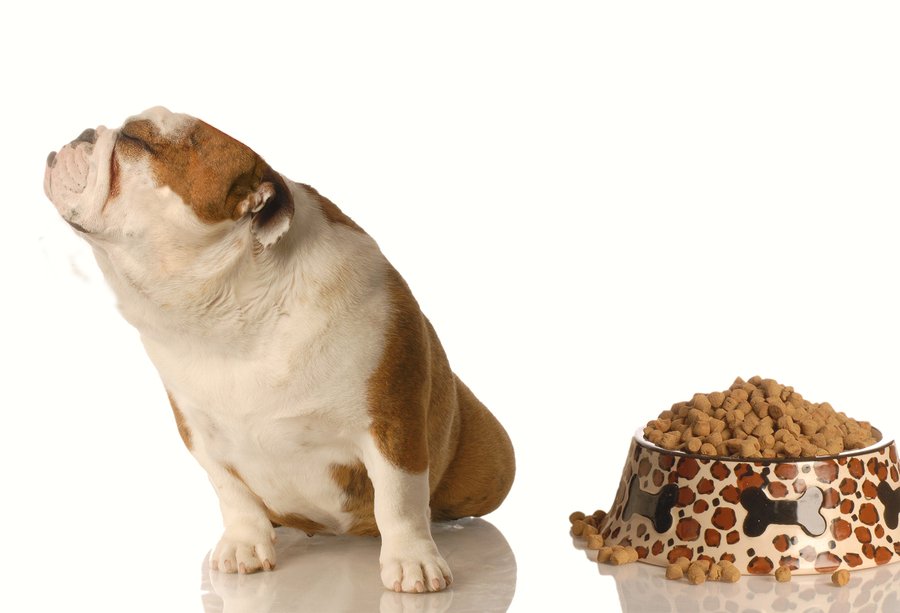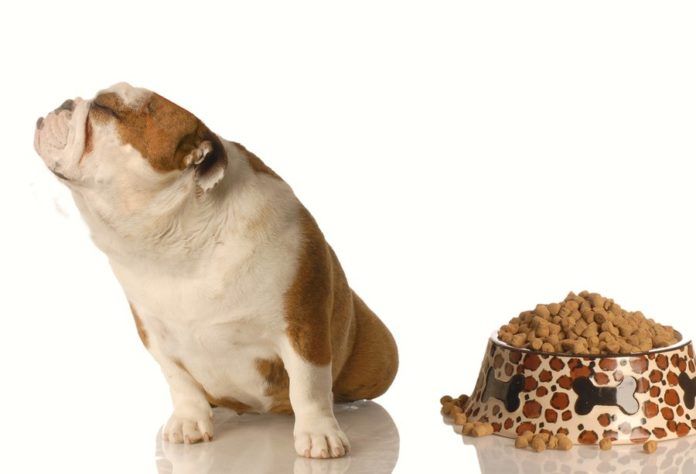© Willee Cole | Bigstock

It’s not just cats. Some dogs turn up their noses at food, too, worrying their “parents” that they’re not taking in enough calories — or won’t unless they’re fed more enticing fare. Are these picky eaters born that way, or molded that way by their owners?
“Certain breeds just tend to be on the thin side,” says Tufts veterinary nutritionist Deborah Linder, DVM, DACVN. Greyhounds and poodles come to mind, she notes, but they’re not the only ones. “There simply are dogs who eat to live instead of live to eat,” the doctor comments, “and you may have to watch with them that they’re taking in too few calories.” These are the dogs who are born to be thin. It’s just in their makeup to eat on the light side.
Then there are the eaters we help train to be picky, and who train us in turn to faithfully indulge the pickiness we have helped cultivate. And they’re not necessarily trim at all. “It’s very common to hear about the picky obese dog,” Dr. Linder notes. This is not a dog who won’t eat but, rather, one who won’t eat unless the food put in front of her is calorie-dense “people food” that she has helped accustom her human family to feeding her by holding out.
Of course, there are also many dogs who don’t eat enough, or don’t eat right, because they have a medical condition that makes them nauseated or takes away their appetite in other ways. But we’re talking here about healthy dogs who either just aren’t that into food (owners of Labs need not pay close attention here) or have learned through their owners’ feeding habits not to be into regular kibble and instead have become used to eating the rich dietary fare they prefer, though it may be harmful to them by dint of either having too many calories or being unbalanced in terms of nutrients.
Either way, where do you start?
For the dog you fear is too thin
Before you decide that your dog’s too thin, or at risk for becoming too thin, take her for a visit to the veterinarian. So many dogs are overweight these days — upwards of 40 percent of them, by some estimates — that too fat now looks normal, and a healthy weight often looks too thin. Let the doctor make a professional assessment. What seems pencil-thin to you compared to all your dog’s neighborhood peers may actually be just right.
Also worth considering is that a number of people with very small dogs often fear their pet isn’t eating enough because the amount they consume is so very little. But such people may be overestimating the amount of food required. These dogs eat very little precisely because they are very little! The veterinarian can make a professional evaluation about whether the dog is taking in the right amount of food.
If your dog is too thin
In the instance that your dog truly is underweight, it falls to you to try to entice her to eat. It’s okay in such a case to let your motherly instinct kick in and see what you can do to get her to take in more calories. Dr. Linder points out that while a few decades ago pet food wasn’t necessarily manufactured with palatability in mind, today there are many foods available to trigger your dog’s appetite. Dog chow is available in many different flavors and forms — stews, pate, loaf, shredded, chunks, and in various shapes like doughnuts, stars, pyramids, etc. Try different types of foods based on flavors and textures, she suggests, and keep a diary to track what your pet’s preferences are. That way, you’ll help insure that she consumes more calories than she has been.
Along the same lines, watch for food aversions. Remember that time you had a gastrointestinal bug shortly after you had been eating leftover meatloaf for a couple of days, and now even just the thought of meatloaf churns your stomach, not because the food made you ill but simply because you associate it with not feeling well? Well, dogs make the same associations. If a too-thin dog consistently turns away from a particular food even if she hasn’t eaten for a while, respect that aversion and don’t keep trying to see if she will eat it. Keep in mind that some smells linger on bowls that expert doggy noses can pick up, even after bowls have been washed. One way to deal with that is to try using new bowls — or disposable plates — if you’re worried about an aversion.
Consider enhancing your dog’s diet with “people food” ingredients that she likes enough to entice her to eat more. You don’t want your dog to take in more than 10 percent of her calories from such foods, Dr. Linder says. Commercial dog foods have just the right mix of nutrients to keep her healthy, and more than 10 percent of calories from other sources could easily throw off her nutrient balance and compromise her health, including her ability to fight disease. But judicious use of certain taste enhancers might be able to do the trick of getting your pet to eat healthful kibble.
These flavor boosters include chopped chicken breast (50 calories per quarter cup) for pets without protein restrictions, homemade chicken broth (store-bought is usually high in sodium and frequently contains onion or garlic, which are toxic for dogs), low-fat and no-salt-added cottage cheese (50 calories per quarter cup), and honey or maple syrup (60 calories per tablespoon). To put the calorie counts of these enhancers in perspective, a 75-pound dog requires roughly 1,000 calories per day.
If you are going to try enhancers, Dr. Linder advises adding them before your pet has a chance to refuse a food rather than as a “reward” for turning up her nose up at the food the first time.
Finally, suggests Dr. Linder, if your dog has trouble consuming enough calories, check your own stress level. Dogs don’t like stress in the house. Who can eat with people yelling or angry or just generally anxious and out of sorts?
There’s also another kind of stress that can hinder good eating in a dog for whom eating is an issue. It’s the stress of an owner who has become overly invested in their pet’s eating habits and feels anxious about how much their pet is consuming. This anxiety can spill over to your pet, who won’t understand why you get very upset at mealtimes but sure can feel the tension. That, in turn, can make her associate mealtime with the idea that something is wrong or upsetting.
One way to know if your dog isn’t eating enough because mealtime is such a fraught activity for you is to check if she eats normally when pet sitters feed her or a different family member takes charge of mealtime. If that’s the case but it still falls to you to feed your dog most of the time, you can reduce stress during meals by leaving food in timed automatic feeders, or placing the food and your pet in a quiet, separate room in the house where she is left alone to eat. In other words, you can actively remove yourself from the situation so your dog can eat without having to deal with your worry over her food intake in the moment.
If your dog is not too thin but nevertheless picky
As we said earlier, not all lousy eaters are too skinny. Plenty are too heavy because they will eat only calorie-dense foods rather than calorically balanced chow created exclusively for dogs. It’s hard to say which comes first, the dog with the finicky palate or the owner who creates a finicky palate by acting like a short-order cook and working to coax their pet to eat by trying different delectable things until the animal finally “gives in” and consumes, say, the steak or the chicken with special sauce on it. Coaxers in these instances are not doing their dogs any favors. Delicious but nutritionally inadequate foods set up a pet for heath problems that go beyond the obesity that can cause painful joints and other orthopedic travails and make it hard for a dog to live the active life she’s meant for. Nutrient imbalances can even compromise the immune system and make it harder to fight disease.
Admittedly, the problem doesn’t always occur because of an owner’s misguided efforts to make a dog happy. Some dogs start holding out for “the good stuff” even after one or two aberrations from their typical diet.
What’s a dog owner to do in such a situation? “You can be a little firm here,” Dr. Linder says. “Hold your ground for a couple of meals” by simply putting out the kibble and not feeding, say, chicken, if your pet turns up her nose. Unlike the dog who tends naturally to be on the thin side, she will not fade away. She will dig in her heels only so long and then give up. It might seem harsh to you as you’re going through the process, but remember, you’re not trying to punish your dog or even show any anger or exasperation. You’re just making it clear that you have a certain expectation of her. She will get the picture, and you will get a healthier dog that lives longer.
If you feel your resolve wavering, consider this: children want to be made happy with food, too, but you can’t feed their favorite food for dinner every single night. You’d no doubt be compromising their health — and probably rotting out their teeth in the bargain.





